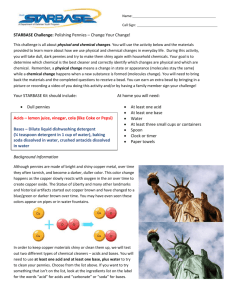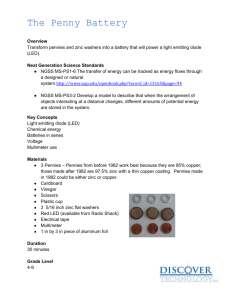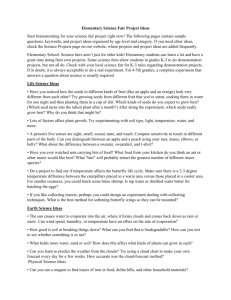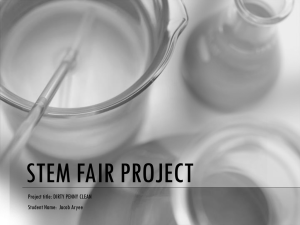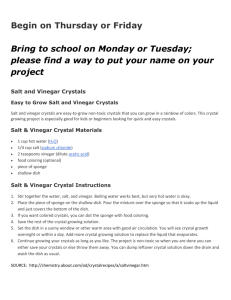Crazy Salsa
advertisement
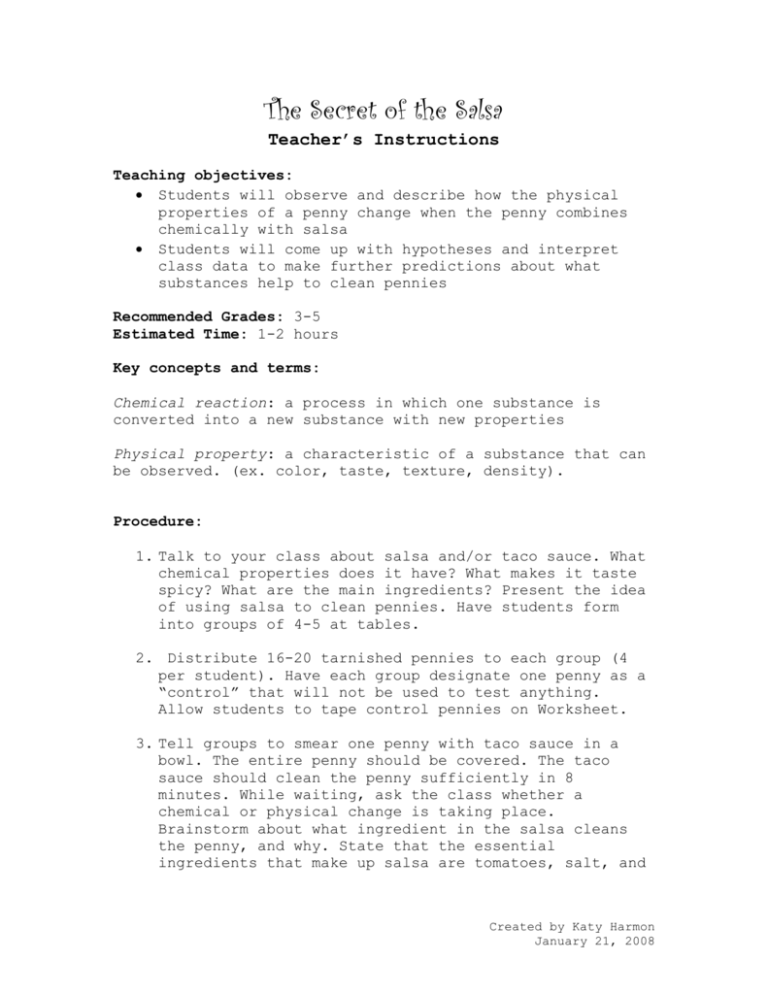
The Secret of the Salsa Teacher’s Instructions Teaching objectives: Students will observe and describe how the physical properties of a penny change when the penny combines chemically with salsa Students will come up with hypotheses and interpret class data to make further predictions about what substances help to clean pennies Recommended Grades: 3-5 Estimated Time: 1-2 hours Key concepts and terms: Chemical reaction: a process in which one substance is converted into a new substance with new properties Physical property: a characteristic of a substance that can be observed. (ex. color, taste, texture, density). Procedure: 1. Talk to your class about salsa and/or taco sauce. What chemical properties does it have? What makes it taste spicy? What are the main ingredients? Present the idea of using salsa to clean pennies. Have students form into groups of 4-5 at tables. 2. Distribute 16-20 tarnished pennies to each group (4 per student). Have each group designate one penny as a “control” that will not be used to test anything. Allow students to tape control pennies on Worksheet. 3. Tell groups to smear one penny with taco sauce in a bowl. The entire penny should be covered. The taco sauce should clean the penny sufficiently in 8 minutes. While waiting, ask the class whether a chemical or physical change is taking place. Brainstorm about what ingredient in the salsa cleans the penny, and why. State that the essential ingredients that make up salsa are tomatoes, salt, and Created by Katy Harmon January 21, 2008 vinegar. Each group should hypothesize which ingredient helps to clean up the penny. 4. At the end of the 8 minutes, have students dry their pennies and tape them to their worksheets. Ask each group to test either salt, tomato paste, or vinegar, making sure every ingredient is tested by at least one group. In a new bowl, completely cover the experimental penny with the ingredient of choice. While waiting, talk about why old pennies get tarnished (See Why it works section) . 5. Nothing worked very well! At the end of the 8 minutes, have students dry their pennies and tape them to their worksheets. Ask a member for each group to report what happened to their penny. Make a table on the board with results (see Sample Table). 6. Hypothesize with the class about what happened. Suggest that a mixture of some of the ingredients together might work. How can you mix together each of the three ingredients? Ask each group to test either salt and vinegar, salt and tomato paste, or tomato paste and vinegar, making sure every ingredient is tested by at least one group. While waiting, have students write down their predictions on the worksheet. Which of the combinations is going to work the best? 7. After another 8 minutes have passed, have students wipe off pennies and tape them to their worksheets. Ask a member for each group to report what happened to their penny. Fill in the table on the board (or draw another one) with results. 8. Explain how salt and vinegar work together to remove the tarnish on pennies. Tomato paste contains acid. Ask the class if they can explain the results. 9. If time permits, have the class design an experiment with a variety of hot sauces, Tabasco sauce, and ketchup. Which do they predict will work best? What actually happens? What does that mean about the ingredients in those sauces? Why it works: Created by Katy Harmon January 21, 2008 What is copper tarnish? Copper tarnishes in a number of ways. Carbon dioxide in moist air creates a layer of copper carbonate of a greenish color, like we see on the Statue of Liberty. Household copper, like a penny, tends to become coated with a black or brown film of copper oxide (CuO) or copper sulfide (CuS). We say this tarnished form of copper has an oxidation state of 2. This copper does not react with salt. The Secret of the Salsa Vinegar, also known as acetic acid, can dissolve the CuO and CuS typical of copper tarnish. However, this reaction takes time. The secret of the salsa is that it contains both vinegar and salt (NaCl, or sodium chloride). A small amount of the tarnished copper on the surface is partially dissolved by the vinegar. We say the copper that is dissolved has an oxidation state of 1, meaning it can react with the salt to become CuCl2-. This allows more tarnished copper to react with vinegar, which in turn reacts with the salt. The CuCl2- is aqueous and is in the solution, rather than on the penny, leaving the bright copper metal beneath it exposed. This means that a combination of vinegar and salt can quickly, effectively remove the tarnish on pennies. Why does a mixture with a lot of salt and a little vinegar make pennies look dull? Salt is good at corroding things. Too much salt, or leaving pennies in the salt and vinegar mixture for a week or so, causes pennies to start corroding again, even if initially they appear shiny. For this reason, you may want to have students take pennies out of the salt/vinegar solution as soon as you notice a change. Why does a combination of tomato paste and salt clean pennies? Most tomato paste contains acid, which like vinegar is able to begin dissolving the tarnished copper on the surface. Sample Table: Penny topping Nothing (control penny) Salsa Tomato Paste Predicted Result Actual Result Created by Katy Harmon January 21, 2008 Salt Vinegar Tomato paste + Salt Tomato paste + Vinegar Vinegar + Salt Supplementary exercises: 1. Try leaving pennies in vinegar for a few hours or overnight. The pennies should be cleaned just as effectively as the salt/vinegar solution. Ask students salt is necessary for the reaction. What does the experiment suggest about vinegar? if 2. Leave pennies in the vinegar/salt solution for a week or so. You should start to see signs of corrosion or a general dullness to the coin. Ask students what they think has happened. Does the vinegar/salt solution clean pennies effectively? Why might time make a difference in the reaction? REFERENCES 1. Rosenhein, L. (2001). The Household Chemistry of Cleaning Pennies. J. Chem. Ed. 78, 513-515. 2. Cleaning pennies with taco sauce. Online: http://cruftbox.com/cruft/docs/cleaningcopper.html. 3. Steve Spangler Science. Online: http://www.stevespanglerscience.com. The Secret of the Salsa Materials List ~120 brown, tarnished pennies (about 4 for each student, plus a few extra) Mild Taco Bell Taco Sauce (others can be used, but this works well) Created by Katy Harmon January 21, 2008 Tomato paste (without added salt) A mixture of tomato paste and salt (2:1 ratio) A mixture of tomato paste and vinegar (1:1 ratio) A mixture of vinegar and salt (in solution) White Vinegar Salt Ketchup (optional) Tabasco sauce (optional) A variety of other taco sauces/salsas (optional) Tape Plastic white plates Plastic bowls Timer Water and paper towels for cleanup Name __________________ Worksheet The Secret of the Salsa Created by Katy Harmon January 21, 2008 Experimental conditions Sample penny What happened? Control Taco Sauce Is this a chemical or physical change? ___________________________ Which salsa ingredient do you think turns the penny shiny, and why? ___________________________________________________ ___________________________________________________ ____________________ ___________________________________________________ __________ Experimental conditions Sample penny What happened? Penny 1: ______________ 1 The Secret of the Salsa Worksheet Created by Katy Harmon January 21, 2008 Which mixture do you predict will clean the penny best? Experimental conditions Sample penny What happened? Penny 2: ______________ Based on the class results, which two ingredients form the best mixture to clean a penny? ___________________________________________________ ___________________________________________________ ___________________________________________________ ______________________________ Bonus Question: You have a hundred dirty pennies. You want to clean them up, but you don’t have any salsa. Which of the following items would clean your penny the best? Circle the best answer. Italian Salad Dressing (contains vinegar) Ketchup (contains salt, vinegar, and tomatoes) Tomato sauce (contains tomatoes and salt) Chicken noodle soup (contains salt) 2 Created by Katy Harmon January 21, 2008
